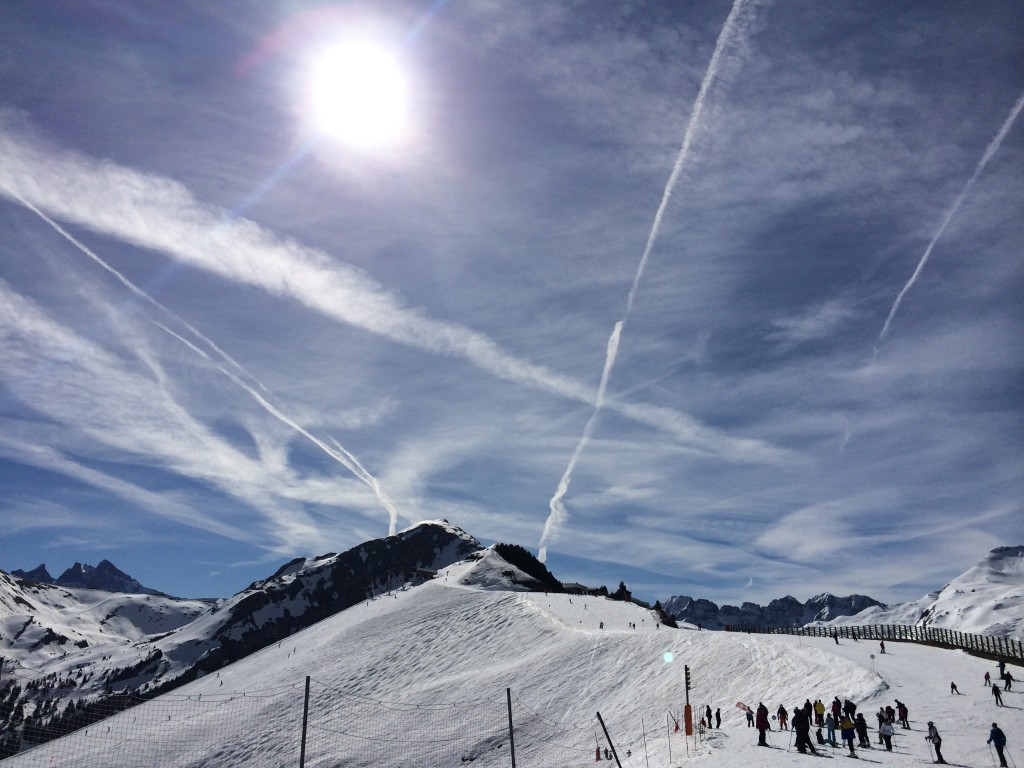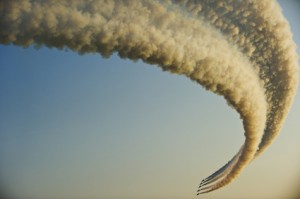When I was in the French Alps skiing last week, I was really struck be the vapor trails being left by the airplanes. This image just below is a perfect example.

The sky was perfectly clear this day, and all of the things that look like clouds have actually come from vapor trails. Early in the morning there weren’t too many trails and, over time (with more planes constantly passing overhead), I saw them start to spread out and dissipate until it’s hard to tell they were originally a vapor trail. After some time, the sky becomes like the image above.
I was surprised that vapor trails could affect the whole sky like we can see above. I began wondering “what are we doing?” and I had to find out some more about vapor trails. Most of what I say below is what I’ve learnt from the links noted at the bottom of this page.
 What are vapor trails?
What are vapor trails?
Vapor trails are also called “contrails” which is short for “condensation trails”. It appears that they really are man-made clouds. Planes spew out exhaust as you’d expect, and this is a bit like us breathing out on a cold day and noticing our breath forming a “cloud”. If the conditions (mostly temperature and humidity) are conducive, condensation trails are formed when the exhaust from the plane mixes with the surrounding air. Water in the air condenses around the particles in the exhaust. When the air is more humid, there is more chance for condensation trails to be generated and to persist for longer.
Do vapor trails cause problems?
Firstly, as you’d expect, the pollution from the exhaust is not very nice in general. When I was researching this, I was a little shocked to read that just one transatlantic flight for a person can create more carbon footprint than a whole year of typical driving. I wasn’t expecting that. If that’s true, then cutting back on flying is much more important for the planet than cutting back on driving (also see Can I reduce fuel consumption by 10% ? and Pollution – someone else’s problem?). This carbon that is being added to the atmosphere can last for centuries and contribute to the gradual warming of the atmosphere.
However, I also wasn’t expecting to learn this next fact.
The vapor trails, or contrails, are essentially adding more cloud to our skies, and it’s the type of cloud that traps heat on the earth’s surface, meaning that it can quickly cause heating of the atmosphere. There are lots of scientific studies out there into this, but still it seems that people argue whether it’s true or not. One of the most interesting lessons learnt was during the three days of US airspace shutdown after the September 11th attacks in 2001. During these three days the biggest daily temperature variations for the previous 30 years were noted. That seems to be fairly convincing proof that vapor trails are having an important and rapid effect on the temperature we’re feeling at the Earth’s surface.
That’s a little (probably more than a little) scary to me. Humans can have a profound and rapid effect on the planet we are supposed to be looking after to pass on to future generations.
 What can be done?
What can be done?
Apparently only a small part of the sky is conducive to production of vapor trails at any given time, so planes could avoid these areas or fly at different altitudes. It’s also possible to change the engines because it’s known that different types of particulates in the exhaust can reduce the occurrence of vapor trails. But here, it must be remembered, we have is a two-fold problem, one of pollution in general plus one of vapor trails that can cause rapid heating.
It’s not good to pollute
It’s easy for scientists to argue about whether what’s been noted above is true or not. Or they can argue about the importance of these facts. However, I hope nobody would argue that there are no laudable aspects to pollution. I can’t think of any. The bottom line is that it’s bad to pollute.
Even if you don’t believe in global warming or the effect of vapor trails, let’s agree that it’s not a good idea to pollute the world. We, as parts of global humanity, can find ways to use our incredible intellect and ability with technology to do what we want to do without polluting and damaging the world, and it would be helpful to find these ways urgently. Time is running out.
A friend made the following comment to me – “Peter, go through the arithmetic, contrails are insignificant”.
Here is my reply – “Keith, that’s what I thought as well, but then I saw the sky filled with contrails while I was skiing and thought that doesn’t look insignificant. Then there’s research that suggests that things that look small can tip the balance for the planet. I don’t want to argue whether the research is correct or not, but I’m happy thinking that polluting a bit less can’t be a bad thing.”
And his response – “Yes, polluting a bit less is good, but don’t advocate a safe, low emission, efficient transport system unless you have something better. And certainly don’t do it because you looked up in the sky and saw contrails once. Look up now – any there? None here, lucky to see one a week here. And that’s the key. At any point on the earth at any time, there is very little. Contrails are orders of magnitude less than the daily noise level in cloud cover variation.”